TAKENOKO [ASMODEE UK BOARD GAMES CLUB]
Takenoko was gifted to us as part of a collaboration with Asmodee UK
Click here for our Toy Review Catalogue to read our reviews before you buy!
Last month we reviewed The River, a board game from Days of Wonder as part of the Asmodee UK Board Games club.
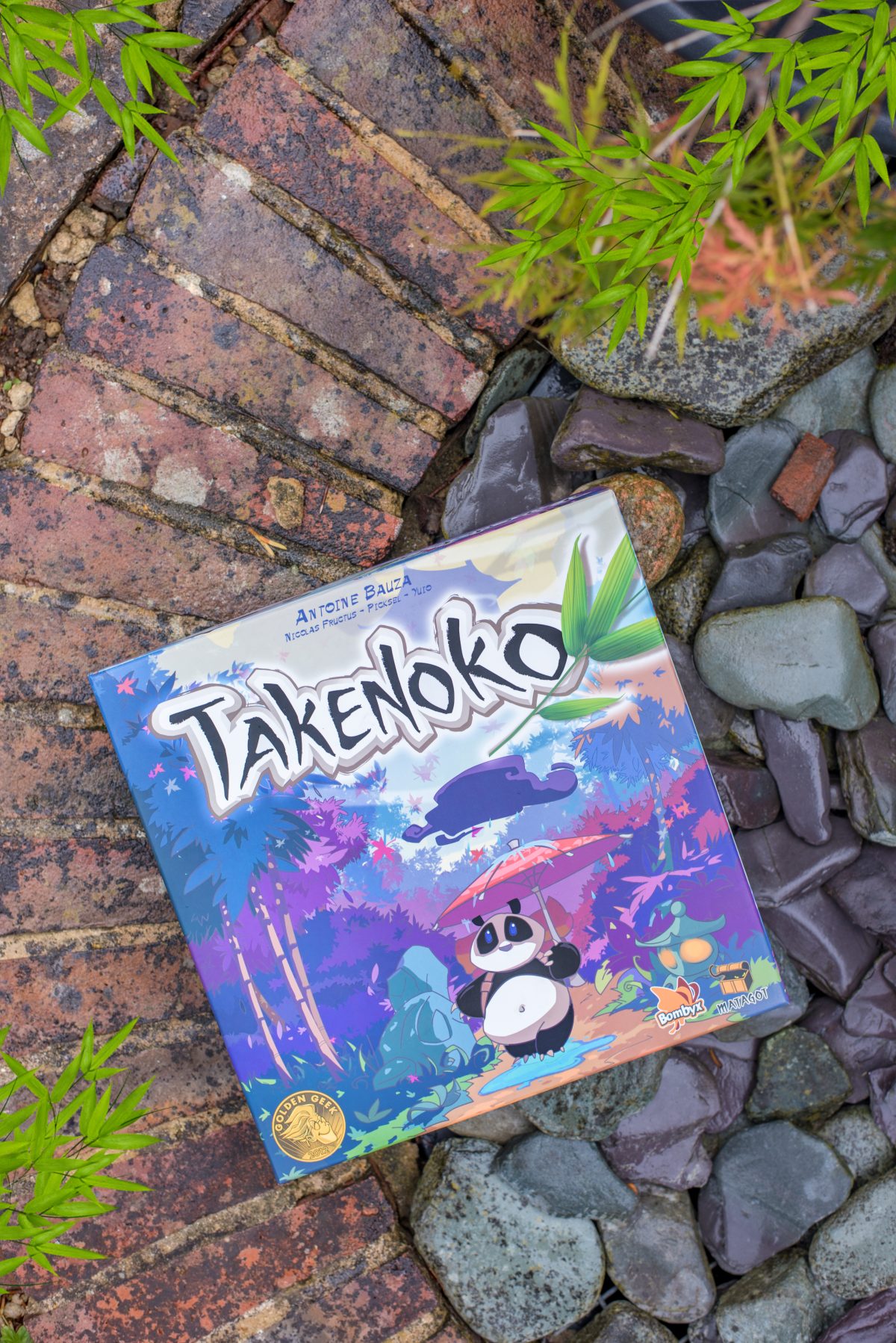
When there’s a panda on a board game box, you’ve got to try it. And so we did, thanks to Asmodee UK. Japanese culture has always been hugely fascinating to us – the food, the language {I spent a year learning to speak, read and write Japanese whilst I was in postgraduate school}, the clothing, the toys and stationery – and that’s before we even get into Tokyo Disneyland – and so we were interested to see what Takenoko held for us. Also, Lyoto is all about bears – and pandas are right at the top of his bear favourites list – so when Takenoko arrived with our long suffering postman, he was desperate to get his paws on it [sorry] and start playing.
TAKENOKO

Simply put, Takenoko is a beautiful family game where the players control a greedy little panda and frustrated gardener whilst building a Japanese zen-come-bamboo garden owned by the Japanese Emperor. The game is recommended for children 8 years and above, is suitable for 2-4 players and generally plays in around 45 minutes.
AWARD WINNING
Distributed by Asmodee UK, Takenoko was designed by Antoine Bowser, also famed for designing Seven Wonders [we’ll be reviewing this soon] and Hanabi – and since being published by French publishers Bombyx and Matagot in 2011, Takenoko has been an award winning favourite across the board [Sorry. Sometimes I can’t stop].
THE WHOLE PACKAGE
If you’ve bought Takenoko, the first thing that will have lured you to it will be the box – the artwork is gorgeous, with a vibrant mixture of light and dark pastels depicting the two main characters in the game – the gardener and panda. Once open, inside lies the most inviting and charming set of rules created in the style of a comic, complete with a one page strip giving the background to the game.
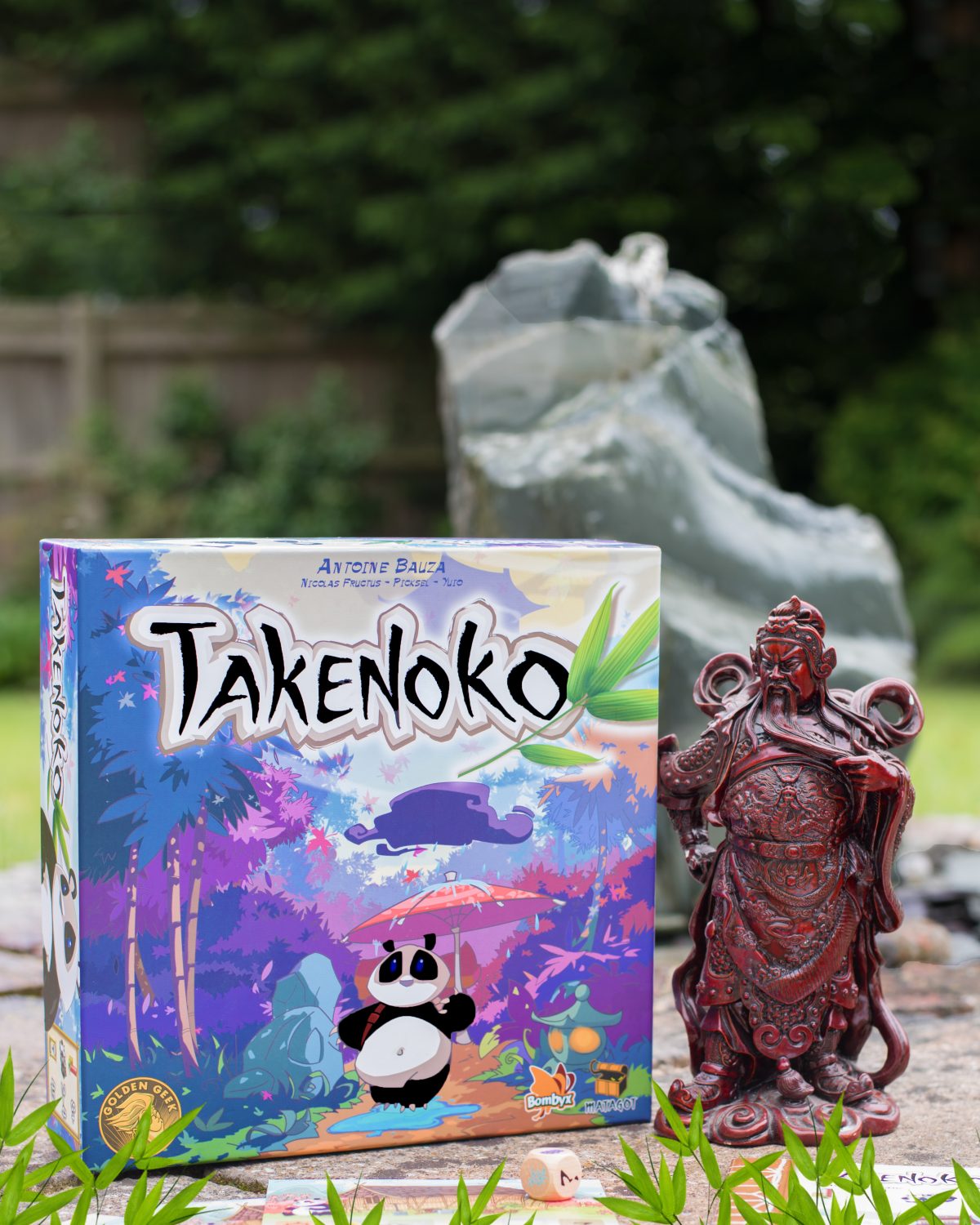
THE STORY OF TAKENOKO
Once upon a time, a Chinese Emperor gifted a precious panda to a Japanese Emperor. This great and generous gift from the Chinese Emperor was to signify peace and become a symbol of diplomatic harmony between the two great nations. However, this gift, being a panda, needed to be taken care of – a job which was passed to the Japanese Emperor’s gardener, a man who has thus far dedicated his life to manicuring and cultivating the perfect zen garden for the Emperor, pouring his heart and soul into each clip, prune and rake of his days. Now saddled with this loveable rogue of a panda, who is forever hungry and constantly destroying any efforts of the gardener to create a bamboo supply worthy of the emperor, he spends his days in a desperate attempt to grow more than the panda can eat, whilst the panda seeks to eat as much as his tummy will allow.
AIM OF THE GAME
Whilst the panda and the gardener are characters in the game to be utilised by each player upon their turn, the players themselves are Japanese Court Members. As Court Members, you are attempting to impress the Japanese Emperor and vying with each other to win his approval through achieving a set number of objectives.
These objectives are represented on cards in three categories – Creating a pleasing Garden Landscape, Feeding the Panda, and Growing the Bamboo. These objectives are therefore achieved by laying coloured terrain tiles, and moving both gardener and panda to add or remove bamboo shoots as needed.
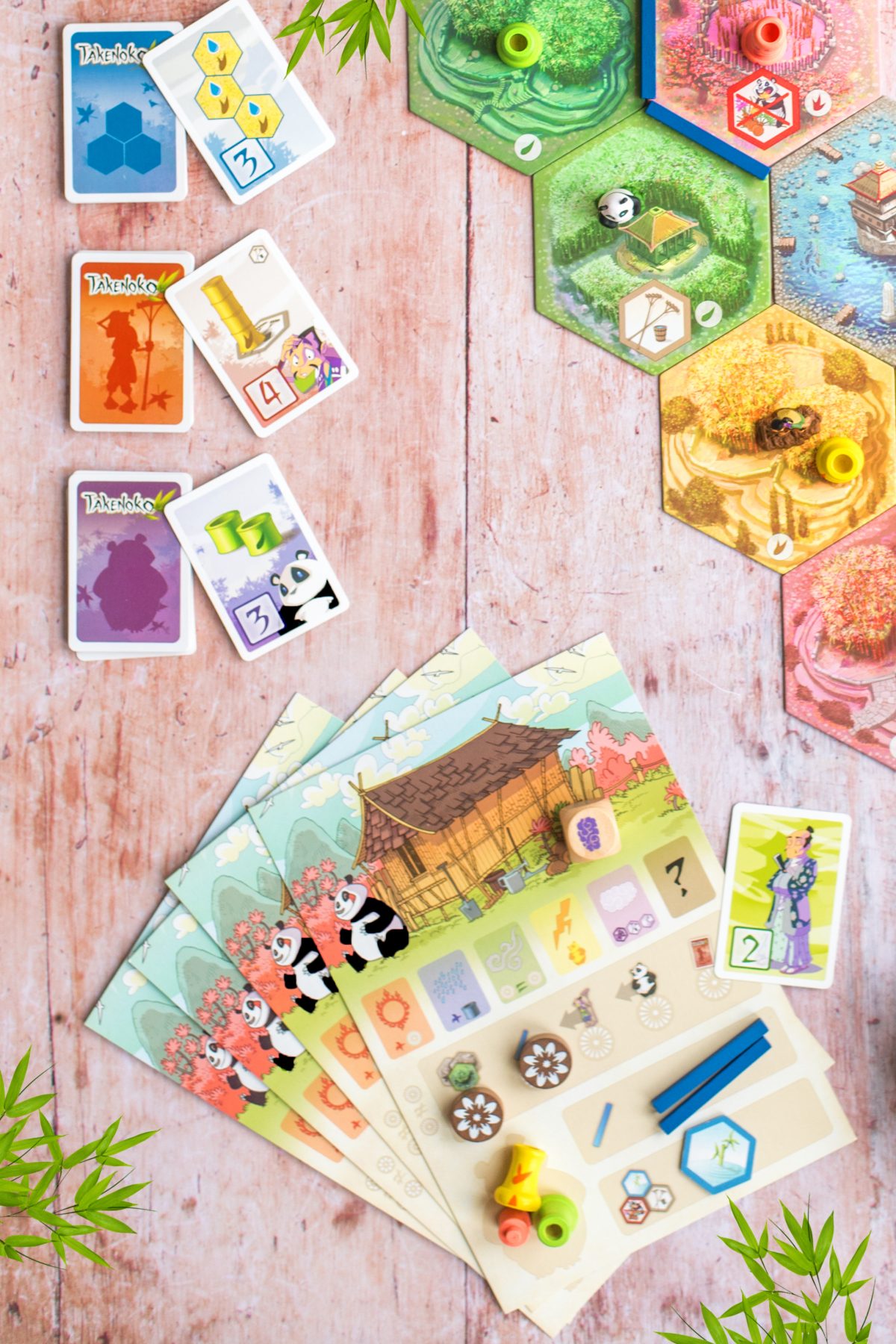
GAME SETUP
Inside the box are a number of different, beautifully made components – each with a very clearly designed space for them to be tidied away into [hooray] ready for play. There are a panda and gardener, four individual player boards [we’ll come to those later], eight action chips in four different designs, irrigation channel strips, 12 improvement chips, a weather dice, an Emperor Card and bamboo shoots in yellow, pink and green. There is also a large stack of hexagonal playing tiles, which represent the plots of land in the zen garden. Within the pile of tiles, there is an initial pool plot for the beginning of the game, and then a selection of pink, yellow and green tiles to create to surrounding landscape throughout the game.
Unlike many board games there is no central board as such. The zen garden starts with a single pond tile, around which players will place and connect other terrain tiles to construct a burgeoning Japanese garden as the game progresses.
ARE THE MEEPLES M.I.A?

No. Don’t panic. There are no individual panda and gardener meeples in Takenoko – throughout the game, upon each turn the panda and gardener seek to carry out the objectives of the player whose turn it is. When it is your turn, you are the gardener and panda. Therefore, At the start of the game, the fully painted panda and gardener miniatures are placed on the starting pond tile, ready for action by the first player – which is the tallest person according to the rules, and which is a shame, because I’m never that person – although I do tend to win a fair bit so maybe going first isn’t all that… ;).
THE INDIVIDUAL PLAYER BOARD
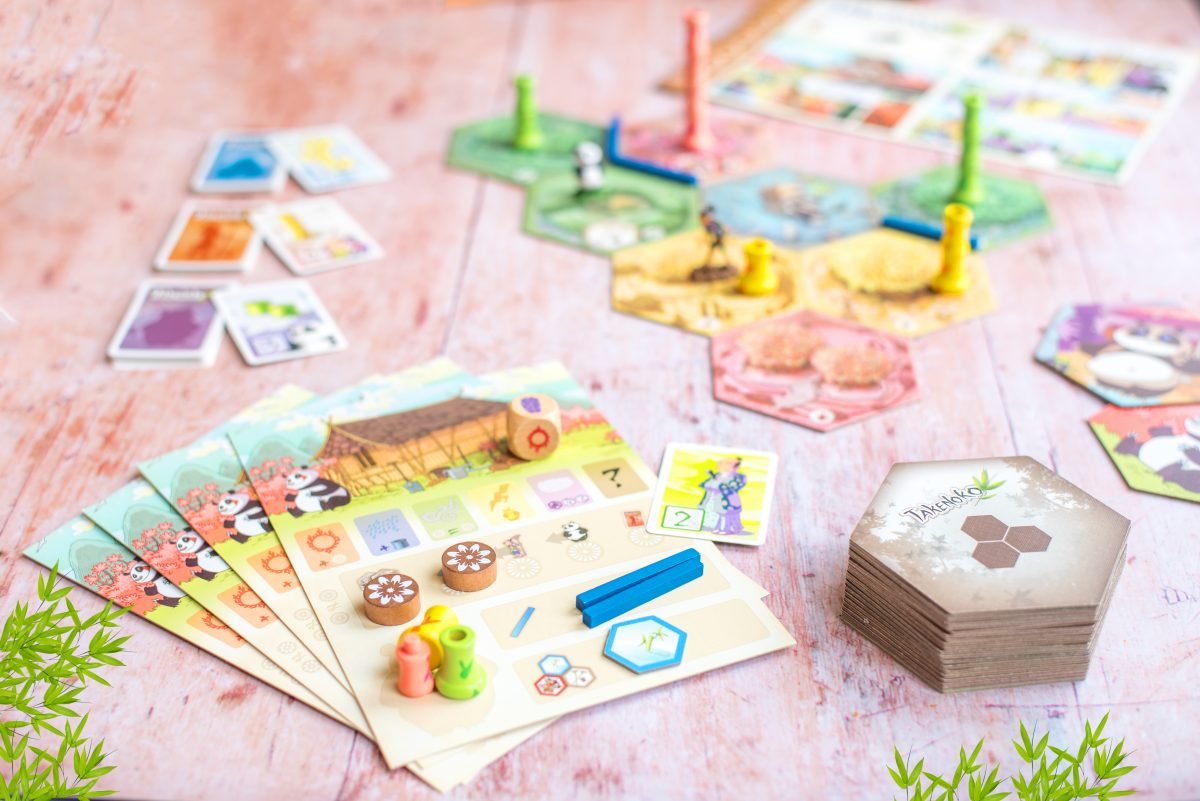
Whilst there isn’t a main board, alongside the terrain tiles or land plots, each player has an individual player board which helps guide their choice of actions in each turn. We’ve read reviews where others have pretty much scoffed at the inclusion of this board and the action reminder chips, believing them to be surplus and of little use – but having met people who love board games but who have challenges with memory or feel pressurised by the need to retain information, and also being one of those people who can honestly walk into a room and forget why I’m there or what I was after in that room, as a family we love these boards. Kudos to Antoine for them.
The Individual Boards have five sections on them – a place for irrigation channel strips, for improvement tokens that you don’t want to spend quite yet, a handy chart reminding in symbol form of the weather dice’s effects, and a reminder of the actions that you’re choosing throughout your turn. The final section is a little panda shadow, which symbolises the panda’s tummy, and bamboo shoots are accumulated here as he eats them on your turn.
ACTION SELECTION
The main mechanism of Takenoko is that of action selection. Upon each turn, a player selects two differing actions from amongst the five possible options shown on their player board. These enable them to:
- Chose a plot tile from three drawn at random;
- Place a plot adjoining those already in the garden;
- Take an irrigation channel [which they can either immediately play and irrigate plots already laid, or can elect to place on their player board to save for later]
- Move the miniature gardener figurine in a straight line, stopping wherever the player wishes on that line, and planting or growing a shoot of bamboo on the place he settles, aswell as upon the adjacent irrigated plots of the same colour tile on which he has landed, or;
- Be the panda. The panda is the fifth option for a player to take, who also moves in a straight lineMoving the panda but instead of growing bamboo, he is able to eat a section of any growing bamboo from the plot where he lands. He may only eat one section and may not eat from any tile other than the one where he lands.
OBJECTIVES
Each player starts with a secret hand of objective cards which are made up of three different types of objectives.
Firstly, purple cards with the panda on the back depict amounts and colours of bamboo pieces which the panda needs to consume. Secondly, orange gardener cards illustrate colours and amounts of bamboo to be grown, and finally blue cards with hexagons on the reverse detail the land plot configurations which need to be laid.
As the objectives on the cards are fulfilled, they are revealed face up in front of the player. The end of a game is triggered when during the course of a 2 player game, 9 cards are completed; in a 3 player game 8 are completed and in a 4 player game, the amount lowers to 7 completed cards.
LANDSCAPE, GROW AND MUNCH TO SUCCESS!
Winning Takenoko is simple – impress the Japanese Emperor by closing out the game with a certain number of objectives [which are illustrated on cards] achieved, and by having those objectives completed give you the highest number of points amongst your fellow Court Members when counted up.
YOUR CO-OPERATION IS NOT NEEDED
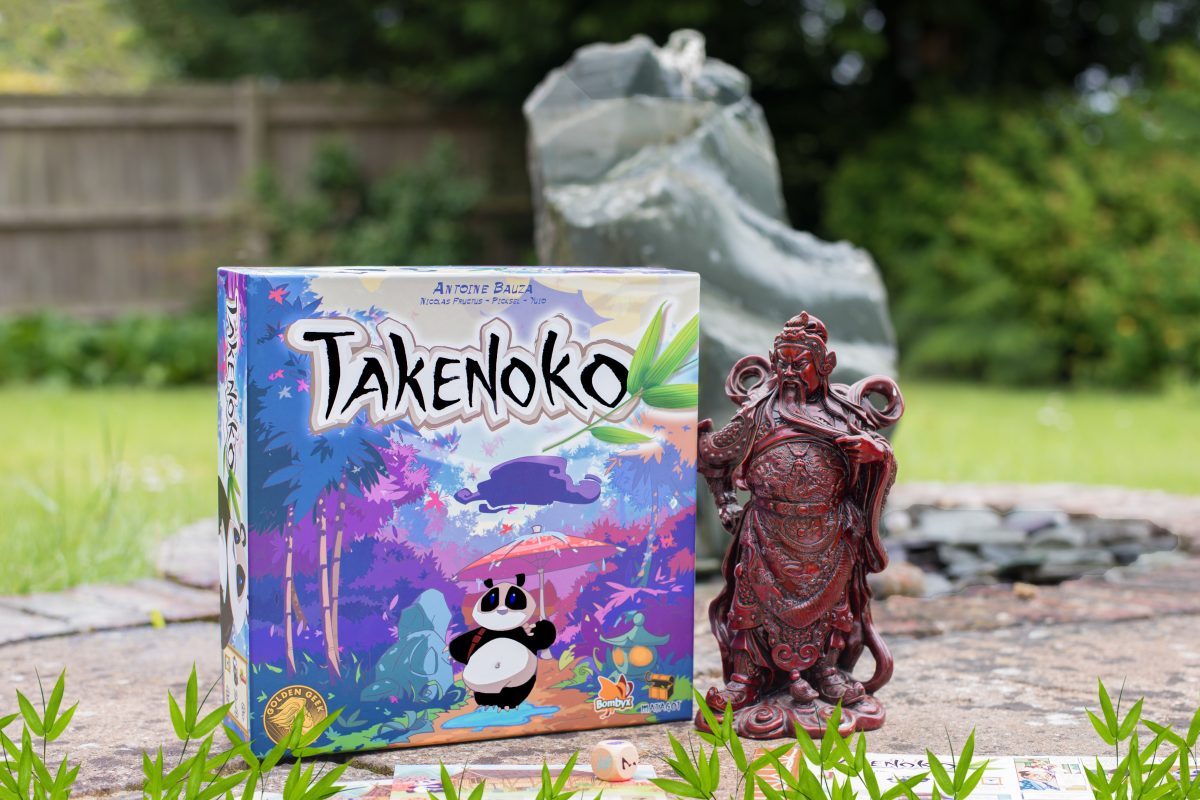
Although by no means a co-operative game, Takenoko thankfully shies away from direct conflict as due to the secretive nature of the cards, each player is completely in the dark as to which objectives the other players are trying to achieve as they go about their business each turn. There is little room for purposeful sabotage, and it’s quite difficult to form an overall strategy when playing, which means it’s a pleasant game especially with younger players as most of the game is down to the luck of the cards, and a bit of tactical thinking when it comes to positioning the panda and gardener.
THE WEATHER
That being said, winning the game isn’t just as simple as moving, growing and eating! No, no, no! As any zen/bamboo gardener knows, the unpredictable nature of the weather can either help or hinder your plans. Because of this, before each turn, players must also roll the weather dice and take their chance with mother nature. If the sun is revealed face up, for example, it shines its nurturing energy down upon the garden giving the player an additional action; perhaps a refreshing wind can blow allowing the player to take two identical actions in the round. On the flip side, there’s also the possibility of rolling a storm icon, which causes the poor frightened panda to scurry away giving the player an extra panda movement on their turn and a tasty shoot of bamboo in his belly section towards an objective.
AND THAT’S NOT ALL
Whilst you’re trying to figure out whether to pray for sun, wind, rain and the like, Court Members’ tasks are made more complex by the addition of improvement marker tiles. There are three types of markers – enclosure markers which are essentially a NO PANDAS ALLOWED tile, forbidding the voracious little furry from devouring any bamboo on that tile where the marker tile is is present. There are fertiliser markers, with little rakes on them, which double the growth of bamboo on the plot tile where it’s placed, and the watershed markers remove the need for that plot to be irrigated by channel strips. Some tiles already have these makers permanently attached to them, so be careful where you lay them!
TAKENOKO – THE JONES FAMILY VERDICT
In summary, in Takenoko each player is trying to achieve as many of their secret objectives as possible by growing the shared garden and moving the gardener and panda to help them in their quest. Once the weather issues have been absorbed into your brain, it’s an easy and fun game to play as a family. It’s a game which has taken into consideration players’ challenges with the individual boards and markers, and is easily playable without tears or sabotage needed – which we always appreciate when we’re playing with the boys and things get a little too competitive [no idea where they got that from…] We also wanted to add that having three colourblind little boys, we really appreciated the symbols being used to represent pink, green and yellow tiles and cards – but it’s a shame that the symbol brilliance didn’t flow through to the bamboo pieces themselves. Overall, Takenoko is beautiful, brilliant and lots of fun to play. ありがと うございまし, Asmodee UK!


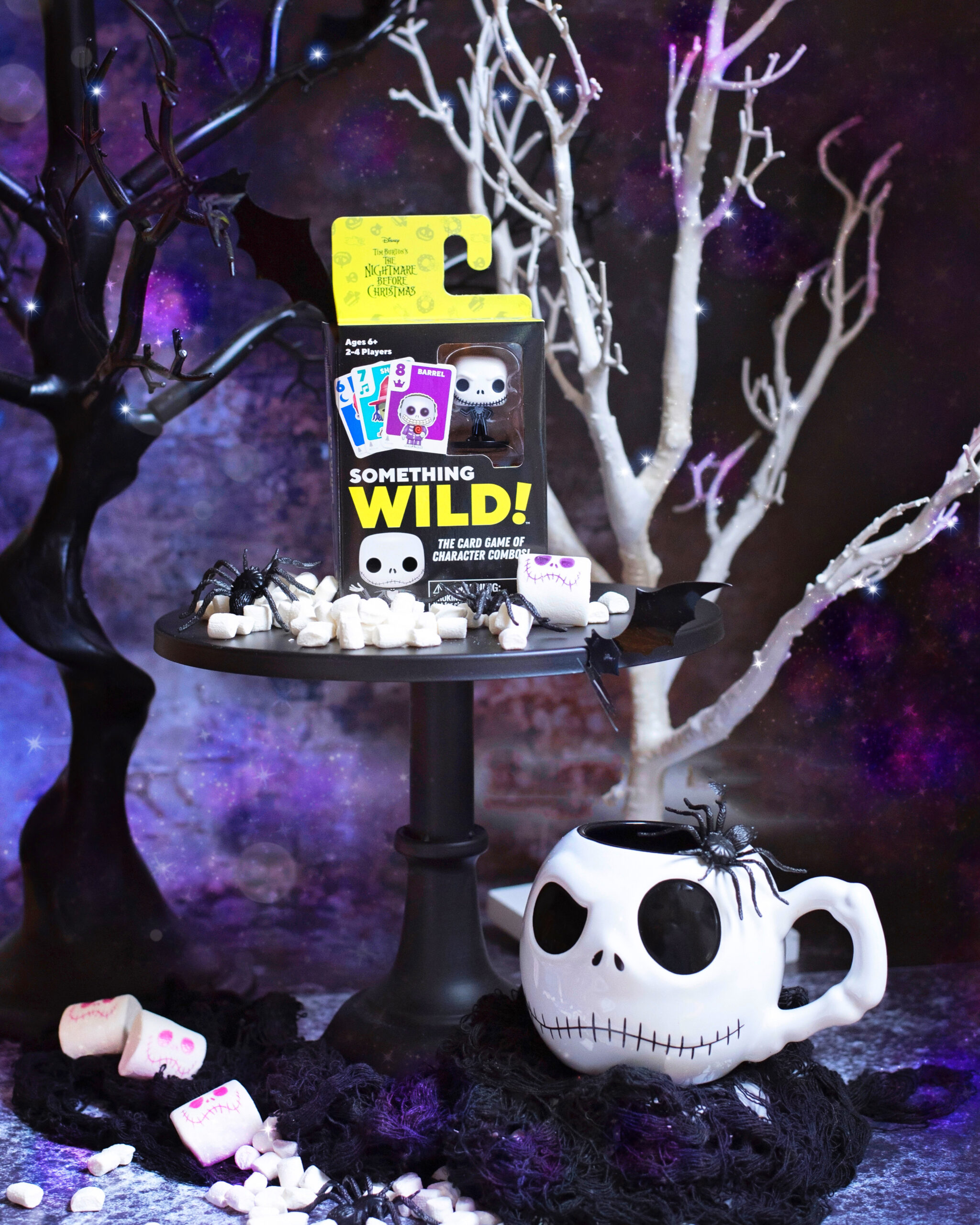

![HATCHIMALS FABULA FOREST REVIEW: TIGRETTE OR PUFFATOO? [#TESTDRIVETUESDAY]](https://keep-up-with-the-jones-family.com/wp-content/uploads/2018/03/Hatchimals-002.jpg)

